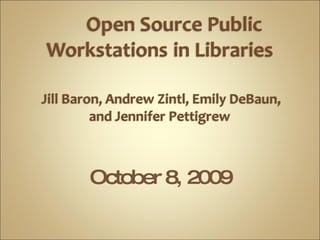
LTR: Open Source Public Workstations
- 3. Reading Room, New York Public Library Reading Room, Bibliotecha Alexandrina
- 11. Eric Raymond +
- 25. Case Studies in Depth: Crawford County Federated Library System and Howard County Library
- 32. Goals (2005) 1. Reduce the maintenance load for the public-access workstations. 2. Reduce the cost of public Internet access while increasing its availability.
- 36. Goals (late 2003): 1. Create low-maintenance kiosks in the Student Union. 2. Avoid Windows security issues.
Notes de l'éditeur
- The title of this LTR is a mouthful. What does it really mean? Before we start lecturing about software and case studies, let’s parse this phrase, beginning with the last word in the list.
- This is the main reading room of the central branch of the NY Public Library (the one with the lions perching out front). A great hall, in the foreground there is a grouping of computer workstations (probably to search the catalog) and then beyond are study tables and stacks. On the right is the reading room of the current library of Alexandria (finished in 200?, UNESCO project, include slide of exterior). Similar set up: computer workstations set amid a large space sanctioned for reading.
- Computer workstations in a college setting. More about this later.
- We all know the distinction between public and private – although in this age of Facebook and Web 2.0, they are not such distinct entities. (include pic of letterman
- Open source is one of those sound bites that I for one have heard a lot but, before this presentation, didn’t know how to define.
- Scientists developed ARPANET in order to communicate and share resources. This was the original form of the internet They collaborated on source code and building the basis of what we now call the Internet. This collaboration, what we would now call “open source”, didn’t have a name. Back then, the scientists probably thought of it as R&D. Once computers took hold – especially personal computers – proprietary software became the norm. Meanwhile, a hacker community took shape, challenging big business with free software and which eventually led to the pivotal moment in 1998.
- Shortly after Netscape made its announcement, Eric Raymond, writer and hacker, championed the term open source in 1998. He and several others in Palo Alto CA seized the opportunity to make a new business model. They renamed “free software” asopen source. The Netscape announcement was a pivotal moment in the hacker revolution.
- This of course applies to libraries! Open source software saves libraries the expense of licensing
- So far we have discussed using open source software in public libraries. However, some of us will become academic librarians at universities. The next 2 case studies focus on how universities can implement open source software.
- Around 2005, library administrators at the University of Vermont, Burlington started to investigate open source software for their public-access workstations. One of their motivations for doing so was the desire to reduce the maintenance load for public-access workstations. Their second motivation was to reduce the cost of providing public Internet access while increasing its availability.
- UVM's library contracted with the vendor Open Sense Solutions to install, maintain, and update 45 open-access Groovix Linux workstations, which had a multi-user configuration and did not require authentication.
- Firefox, OpenOffice, and Adode Reader are some examples of the open source applications that run on UVM mutli-user workstations.
- UVM reported that using Groovix Linux distribution on public-access workstations helped reduce their maintenance load, lowered the cost of public Internet access, and UVM reported fewer software security issues. Importantly, there was no reported user dissatisfaction with the workstations. Overall, library administrations considered the project a success.
- The last case study involves the University of North Carolina Chapel Hill. Late in 2003 UNC decided to investigate using open source software in order to create low-maintenance kiosks in the Student Union while avoiding Windows securing issues.
- To meet their goals, UNC decided to use Linux Terminal Server Project to provide public-access Internet browsing. As explained earlier, LTSP is a thin-client arrangment in which a single Linux server runs most of the processing. Although this case study does not involve UNC libraries, it is an example of how libraries could provide public Internet browsing to users.
- The LTSP Kiosks at UNC run Firefox for Web-browsing and R-KIOSK, which is a Firefox add-on that manages user capabilities. The Kiosks also run surveys and programmable signage for UNC.
- During the project UNC expanded from 5 to 22 terminals that were located in the Student Union as well as other campus locations.
- UNC reported that the project was a success for several reasons. To begin, LTSP is easy to manage. Software updates are handled on the server and are easy to automate. Secondly, the low cost terminal software fit within UNC’s budget; however, UNC recommended investing in quality server hardware to improve performance. Lastly, LTSP increases security because user capabilities can be managed and any user processes can be ended by the server. Neither the UNC administrators or users reported any complaints about the terminals.
- As future librarians and information specialists we might have to make decisions about choosing open source software solutions. As such, we need to be aware of its benefits and drawbacks as an alternative to propriety software.